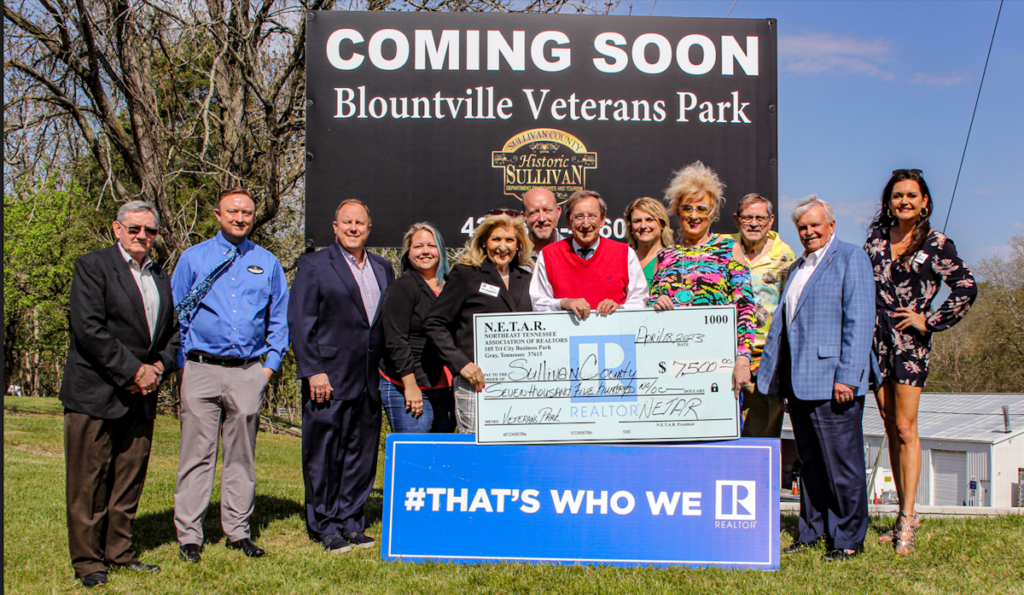NETAR Donation Helps Boost Sullivan Co. Veterans Park
Jan Stapleton - 2023 NETAR President
The Northeast Tennessee Association of Realtors® recently joined other local organizations and individuals with a $7,500 contribution for Sullivan County’s Veterans Park in Blountville. The contribution is both representative of the association’s continuing dedication to civic affairs and a recognition of how important the veteran community is to our region.

2023 NETAR President
Association Spokesperson
Four six-foot granite monuments will anchor the 60-by-40-foot park that is next to the county Heritage Tourism Information Center on Highway 394. Each monument will be dedicated to 100 years of history as the park honors veterans across four centuries.
The ranks of Tri-Cities veterans have thinned since the days before the pandemic. They made up almost 10% of the population in 2019. The latest count drops that share to 9% of the region’s population 18 years-old and older.
Veterans have a rapidly aging demographic. There are 2,281 fewer Korean War and World War II vets than before the pandemic. And despite the region’s first-class veterans facilities and accommodating colleges and culture, the region isn’t drawing as many after their service as it has in the past.

Here’s a snapshot of the local veteran population and how their ranks affect the overall population:
PERIOD OF SERVICE
According to the Census Bureau, there are a little over 40,603 veterans living in the Tri-Cities region. The highest percentage of them are Vietnam-era vets. Here’s how the period of service for the local veteran population looks. The Census totals are for the Johnson City and Kingsport-Bristol metro areas. Totals were not available for the Greeneville metro area.
Gulf War, 2001 or later – 8,491 (23.4%)
Gulf War, 1990 – 2001 – 7,516 (20.7%)
Vietnam era – 14,836 (40.8%)
Korean War – 1,345 (3.7%)
World War II – 146 (0.4%)
AGE, GENDER, INCOME
The veterans’ community is predominately male (91.3%), and – like the overall vet population – reflects a decline in numbers. Currently, there are a little over 33,000 male vets, down from almost 35,000. There are 3,164 female vets, down from the pre-pandemic count of 3,896.
Although there are fewer female vets, they have a higher individual economic footprint than their counterparts. The median income for female vets is $43,493 compared to $23,480 for civilian females. It also outranks the $36,408 median income for male vets. The civilian male income is $32,766.
The local veterans’ population also had a higher share of members (92.5%) with incomes at or above the poverty level compared to the non-veteran portion of the population (84.4%).
And, as expected, veterans tend to make up a larger portion of the region’s elders.
Here’s how the percentage of veterans in their population group compares to the civilian population. The percentage of veterans is the first listing.
18-34 – 6.4% – 26.5%
35-54 – 30.3% – 30.9%
55-64 – 18.1% – 18.4%
65-74 – 15.7% – 14.3%
75 and over – 24.2% – 9.9%.
EDUCATION
Among their population group, veterans have a slightly higher education level than the non-veteran population. The veterans’ population group share is the first listing, followed by the non-veteran population.
Less than high school graduate – 6.9% – 11.9%
High school graduate – 33.9% – 34.1%
Some college or associate degree – 32.9% – 29.1%
Bachelor’s degree or higher – 26.3% – 24.9%
NETAR is the voice for real estate in Northeast Tennessee. It is the largest trade association in the Northeast Tennessee, Southwest Virginia region, representing over 1,800+ members and 100+ business partners involved in all aspects of the residential and commercial real estate industries. Weekly market reports and information for both consumers and members are available on the NETAR website at https://netar.us
